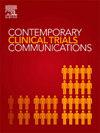Trialing addiction neurocircuitry targets and directionality of brain stimulation effects: A deep TMS/fMRI trial in people with alcohol use disorder
IF 1.4
Q4 MEDICINE, RESEARCH & EXPERIMENTAL
引用次数: 0
Abstract
Background
Excessive alcohol consumption is a global health concern, with an estimated 400 million people living with alcohol use disorder (AUD). Current treatments for AUD have limited efficacy and fail to address its diverse neurobiological underpinnings. There are at least two cortico-striatal circuits relevant to AUD neurobiology: a weakened dorsolateral prefrontal cortex (dlPFC) pathway, and a heightened ventromedial prefrontal cortex (vmPFC) pathway.
Purpose
This trial aims to examine whether deep transcranial magnetic stimulation (dTMS) can recalibrate the neurocircuitry disrupted in AUD as a proof-of-concept for its therapeutic potential. We will assess the capacity of two theta-burst stimulation protocols to modify neuroimaging and behavioral indices of AUD-related neurocircuitry alterations.
Methods
We will conduct a randomized, single-blind, sham-controlled crossover trial with 30 adults with moderate to severe AUD (aged 18–49). Participants will receive two doses of active or sham dTMS (for 2 sessions; 7 days apart; order counterbalanced) targeting the dlPFC or vmPFC with intermittent or continuous theta-burst stimulation, respectively.
Results
Primary, secondary, and exploratory outcomes (i.e., stimulation-induced changes in neural circuit connectivity, executive control/decision-making, and craving-related emotions, respectively) will be collected before and after each dTMS dose. Additional exploratory outcomes (daily craving experiences and weekly alcohol consumption) will be collected across a 90-day period from the first session.
Discussion
This trial innovates by utilizing distinct dTMS approaches to specifically target two functionally segregated neurocircuitries disrupted in AUD. Results will inform the development of a larger-scale trial by establishing optimal therapeutic approaches for AUD.
试验成瘾神经回路靶点和脑刺激效应的方向性:酒精使用障碍患者的深度TMS/fMRI试验
过量饮酒是一个全球性的健康问题,估计有4亿人患有酒精使用障碍(AUD)。目前对AUD的治疗效果有限,未能解决其多样的神经生物学基础。至少有两个与AUD神经生物学相关的皮质纹状体回路:一个减弱的背外侧前额叶皮层(dlPFC)通路和一个增强的腹内侧前额叶皮层(vmPFC)通路。目的:本试验旨在研究深度经颅磁刺激(dTMS)是否可以重新校准AUD中被破坏的神经回路,作为其治疗潜力的概念验证。我们将评估两种脉冲刺激方案的能力,以改变aud相关神经回路改变的神经影像学和行为指标。方法我们将进行一项随机、单盲、假对照交叉试验,纳入30名患有中重度AUD的成年人(18-49岁)。参与者将接受两剂活性或假dTMS(2个疗程;间隔7天;顺序平衡)分别用间歇或连续的脉冲刺激来靶向dlPFC或vmPFC。结果收集每次dTMS剂量前后的主要、次要和探索性结果(即刺激诱导的神经回路连通性、执行控制/决策和渴望相关情绪的变化)。额外的探索性结果(每天的渴望经历和每周的酒精消费)将在第一次会议后的90天内收集。该试验的创新之处在于利用不同的dTMS方法专门针对AUD中两个功能分离的神经回路。通过建立AUD的最佳治疗方法,研究结果将为开展更大规模的试验提供信息。
本文章由计算机程序翻译,如有差异,请以英文原文为准。
求助全文
约1分钟内获得全文
求助全文
来源期刊

Contemporary Clinical Trials Communications
Pharmacology, Toxicology and Pharmaceutics-Pharmacology
CiteScore
2.70
自引率
6.70%
发文量
146
审稿时长
20 weeks
期刊介绍:
Contemporary Clinical Trials Communications is an international peer reviewed open access journal that publishes articles pertaining to all aspects of clinical trials, including, but not limited to, design, conduct, analysis, regulation and ethics. Manuscripts submitted should appeal to a readership drawn from a wide range of disciplines including medicine, life science, pharmaceutical science, biostatistics, epidemiology, computer science, management science, behavioral science, and bioethics. Contemporary Clinical Trials Communications is unique in that it is outside the confines of disease specifications, and it strives to increase the transparency of medical research and reduce publication bias by publishing scientifically valid original research findings irrespective of their perceived importance, significance or impact. Both randomized and non-randomized trials are within the scope of the Journal. Some common topics include trial design rationale and methods, operational methodologies and challenges, and positive and negative trial results. In addition to original research, the Journal also welcomes other types of communications including, but are not limited to, methodology reviews, perspectives and discussions. Through timely dissemination of advances in clinical trials, the goal of Contemporary Clinical Trials Communications is to serve as a platform to enhance the communication and collaboration within the global clinical trials community that ultimately advances this field of research for the benefit of patients.
 求助内容:
求助内容: 应助结果提醒方式:
应助结果提醒方式:


